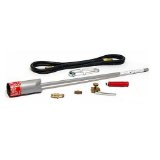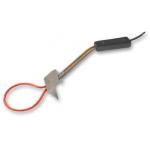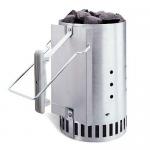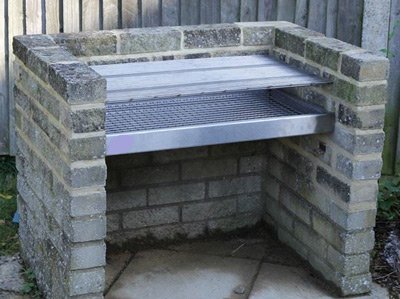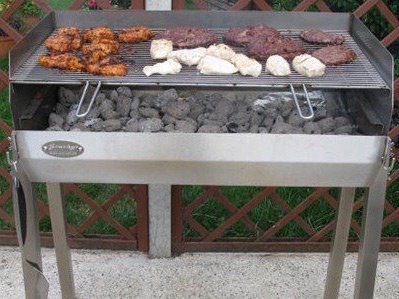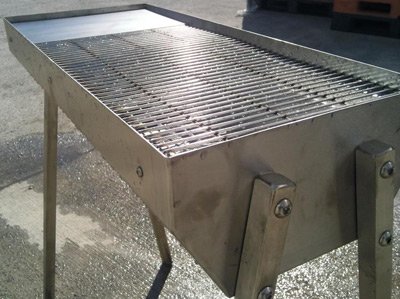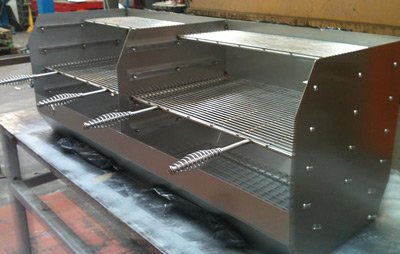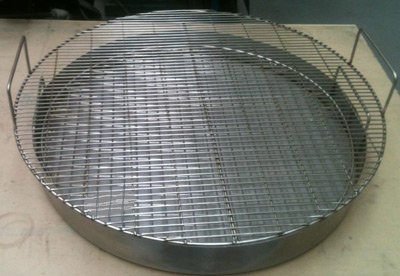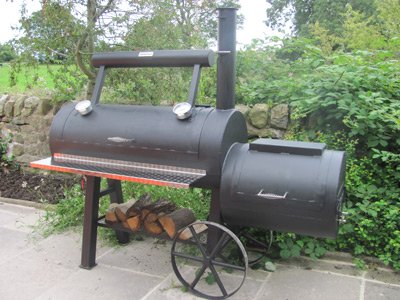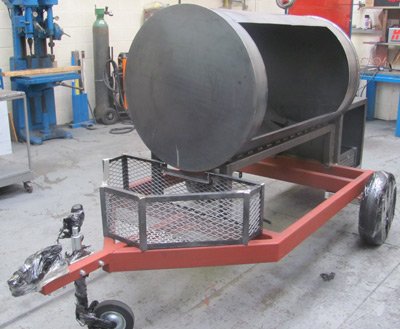- Recipes Home
- Pitmaster Tips & Techniques
- About BBQ Charcoal
Lumpwood Barbecue Charcoal Or Briquettes?
Is it to be lumpwood barbecue charcoal? Should I get the instant lighting packs? Or maybe BBQ briquettes? How do I light it and do I need a charcoal chimney starter?
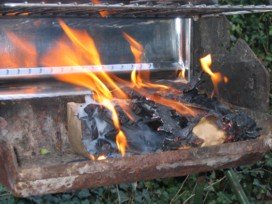
Before we go any further let me please remind everyone of the dangers of fires and remember never to blow onto the coals – you’ve only got two eyes, keep your barbecue cookout safe.
What Is Charcoal?
Barbecue charcoal is traditionally made when hardwood timber is heated up to approx 600 - 700°C in an oxygen starved environment which stops the wood from catching fire. If oxygen were present then the wood would burn rather than char and you would basically be left with a load of ash as you would in a log fire grate.
Technically you can make charcoal from waste materials or even animal bones but barbecue charcoal in general comes from wood (virgin hardwood is preferred to softwood) although Marabu from an invasive species, and coconut shell from waste are also popular options. They both give long burn times and offer an element of sustainability but travel footprint to the UK is higher than locally sourced. To read more about sustainability click here.
There are two types of charcoal:
- Lump - this is the charred remains of the raw material
- Briquettes - a block of charred wood dust combined with tar and cornstarch (as described by automobile entrepreneur Henry Ford)
How Is Barbecue Charcoal Manufactured
There are two main manufacturing methods for barbecue charcoal:
- Kiln - This is the oldest and most traditional and most typically for hardwood. A fire is lit under the woodpile to be charred, a cover is placed over the top and earth is banked up around the sides.
- Retort - This is a sealed chamber in which the product to be charred is placed. The difference is that the fire doesn't come directly into contact with the wood (or material being charred) and it's effectively a destructive distillation process. A retort is in essence a purpose built piece of kit designed specifically for the job and production times are reduced to hours rather than days. It's also important to note that a retort burns the vast majority of the smoke that it produces so it is a much more environmentally friendly production method from a particulate perspective.
Which Is Best? Lumpwood Or Briquettes
It depends on your barbecue. I must confess to being brought up with the perception of lumpwood being the purist's choice.
- A clean burning lumpwood leaves very little ash to clear up
- Lumpwood is completely natural so as a food ingredient, flavour can be infused too
- Briquettes leave significantly more ash because a briquette contains more than just charcoal
- Briquettes generally have much longer burn times and usually offer more stable temperatures for long cooks
Frankly speaking the answer to which barbecue charcoal is best depends on the equipment that you are cooking on as well as what you want to cook. I do a lot of cooking on a kamado and kamado cooking temperature is controlled by airflow through the firebox. The ash from briquettes can clog up the air holes in the firebox so all kamado manufacturers will recommend lumpwood charcoal. Really cheap briquettes can also have chemical nasties which would infuse into the kamado ceramic so that's another reason to say no.
I also cook on a Pit Barrel Junior and this is definitely better served by feeding it on briquettes because they offer uniform heat intensity & good burn time with a cooker that runs relatively hot and fast. Weber kettles and smokers are other case in points.
But Lumpwood Charcoal Quality Is So Variable
While the briquette manufacturing process is well established and is used as a heat source in many industries as well as for us barbecuers. That doesn't mean that individuals won't have brand preference but for the larger part, most brands of briquettes offer a consistent size and composition of briquette and therefore an equally consistent level of performance. Some premium types such as the coconut shell and the compressed hex or cube shaped briquettes do boast even longer burn times over the more well established pillow shaped ones.
The same however is not true of lumpwood. It comes in different shapes and sizes and there's also a wide variation in price. What is best and how can you tell?
It's All About The Smell And The Taste
Lumpwood varies due to the type and purity of wood used. Generally speaking, hardwood is best and the more expensive brands will be using hardwood. Hardwood offers higher burn temperature and longer burn times.
More often than not, the less expensive brands (and generic supermarket charcoal) will be soft wood. They may contain accelerants, they may be charred from old varnished / polished furniture and all these added chemicals will deposit unwanted petroleum based odours through your cook and taint the flavour of your food.
This might sound daft but take a piece of lumpwood charcoal and treat it like a piece of food. Smell it....then taste it. If it's good quality then there's little to smell or taste, if you get a hint of solvents then steer clear.
Let’s start with worst - instant lighting barbecue charcoal. This is the stuff that comes wrapped up in a brown paper bag (pictured below) and you place it in the grill and light the paper. Generally it works but occasionally you get a bad lot and it doesn’t burn and because it is impregnated with fuel it will taint the flavour of your food. The burning paper creates a lot of light ash which can rise up and stick to your food and worst of all, it doesn’t last very long. Just avoid this stuff.
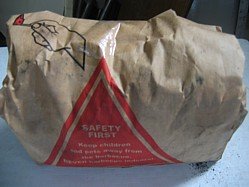
Good quality lumpwood charcoal can be as much as three times the price of the cheap stuff but it's worth it because:
- The flavour of the wood will come out in your cooking rather than the impurities. Consider the charcoal like any other recipe ingredient.
- The charcoal will burn at a higher temperature and last longer so you can use significantly less charcoal per cook
That said, there is still one marketing myth that is good to understand and that's the myth around big charcoal chunks. Let's be clear, you don't want to be cooking on dust but what's important is a consistent size of chunk rather than absolute size because it follows that consistent size promotes consistent heat (no hot spots) and consistent burn time across the spread of the fire.
Those that are trying to sell you "the right mix of large and small chunks" are just pedalling a myth to explain their inconsistently sized output or boasting about their large sized chunks.
TIP - If you’ve got any BBQ charcoal left over from last
summer then use it sparingly with some fresh charcoal and never try to have a
whole fire with last year's leftovers. Charcoal is a natural desiccant
therefore it absorbs moisture and it never burns as well six months
down the line - you’ll just end up getting frustrated.
Lighting BBQ Charcoal
Every barbecue or smoker will have a set of instructions for how best to light it and one thing I've learned is that the manufacturer usually knows best. That said, the manufacturer guidance will probably fall into one of the three categories below.
How To Light Lumpwood
Firelighter
Pour your coals onto the grill grate, insert an odour free firelighter block into the coals and strike a match.
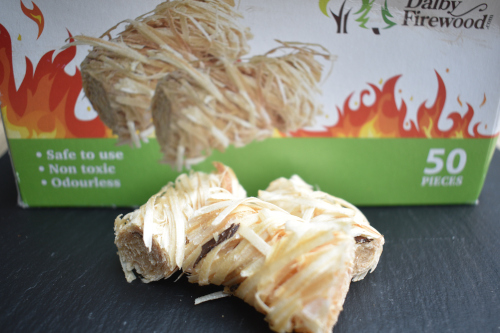
Don't use gel or lighter fluid as both of these leave a petro-chemical taste in the coals. And don't use paper because paper creates a lot of ash that easily rises and this can stick to your food or even stick to your neighbour's washing!
Modern odour free firelighters don't leave any smelly petroleum residue because they are made from waste paper and sawdust soaked odourless biodiesel.
Electric Starters & Pokers
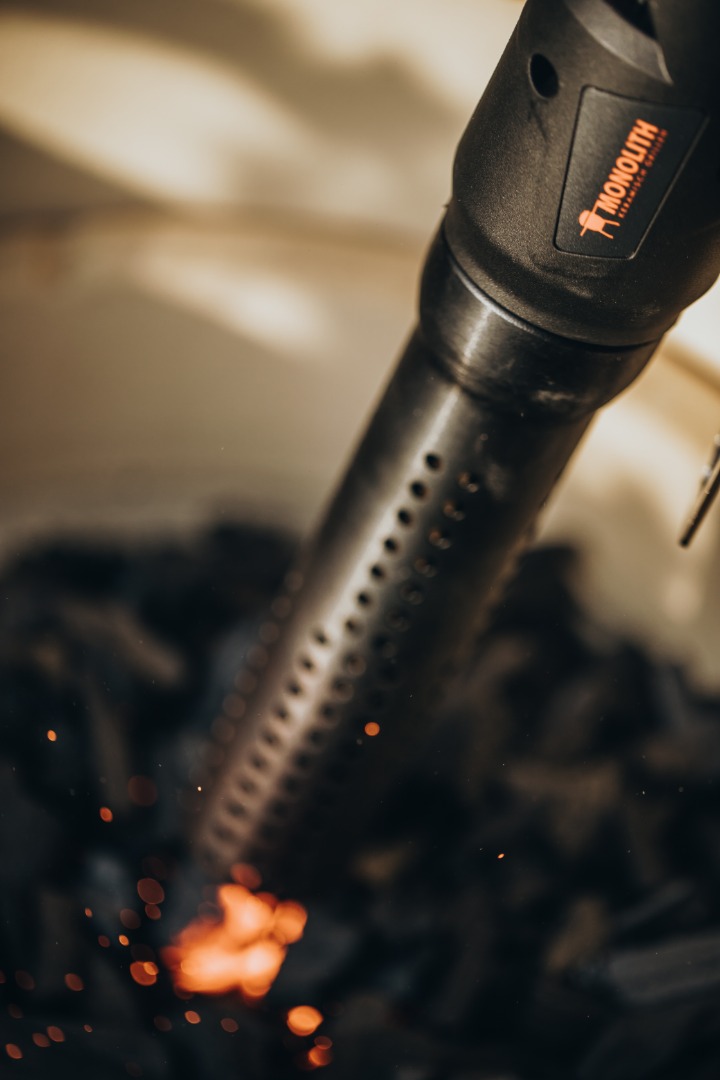 Monolighter
MonolighterYou've probably heard of the most popular brands such as Monolighter and Looftlighter. I can only liken these to a hair drier on steroids.
You hold the tip of the lighter to the coals for about 30 seconds (until you get ignition sparks from the charcoal) then pull it away for a further 30 / 60 seconds so it blows on the coals until they are glowing hot and that's the job done. Ninety seconds to get a fire going is pretty amazing.
This video demonstrates the point nicely.
Note: The Monolighter / Looftlighter is not like the poker lighter described below in that you don't insert the lighter into the coals.
The Monolighter has a slightly higher powered blower than the Looftlighter and the perforated housing is more robust.
The alternative is to use a poker lighter. These either take the shape of a propane torch or they can be electrically powered (like a big soldering iron). Light the torch (or plug in if electric) and insert the starter into the coals for the amount of time recommended by the manufacturer. When done, remove the starter and place it on a heat proof surface until cool.
The propane torch, works almost as fast as the Monolighter / Looftlighter but it can be really frustrating if you run out of gas!
The advantage of the electric poker over the others is that you can leave it unattended but when the alternative takes only 90 seconds, is it any wonder that these pokers are considered outdated?
How To Light Charcoal Briquettes
The easy way to light briquettes is to use a charcoal chimney starter.
All you have to do is roll up a couple of sheets of newspaper and put the ends together to form a circle. Place this circle in the bottom of your charcoal chimney starter and pour the charcoal on top. From the bottom, light the paper and watch the fire take hold moving gently from the bottom to the top.
You can also soak a portion of the newspaper in vegetable oil to give it that extra longevity during the ignition phase.
Alternatively place a firelighter on your grill grate and put the chimney burner over it. In either case, you should have red hot coals in 12 - 15 minutes.
Note: A starter isn't just for briquettes, you can ignite lumpwood this way too.
A chimney starter is the recommended way to start and maintain a fire by many smoker / cooker brands because smoking meats such as brisket or pork shoulder could take a longer time than you can get out of a batch of briquettes so your coals are going to need replenishing with more hot coals because:-
- Fresh charcoal will absorb energy (and therefore reduce the temperature of your food chamber) as you get it going. If you've ever placed your hand near freshly ignited charcoal then you'll know what I mean. It takes time for barbecue charcoal to come up to temperature and the best place for this to happen is in a starter rather than in your smoker.
- The smoke from freshly burning charcoal will obscure the flavour that you're trying to get from your wood chips. The smoke from early combustion of wood product is thick and white, it has a bitter taste and is not what we're looking for when hot smoking. We want the blue wispy smoke that comes during the mid to latter stages of combustion. Using a charcoal chimney starter gets you through that thick white smoke phase before you add the fresh coals.
- Freshly burning barbecue charcoal gives off soot that will leave a black spotty residue on your meat. Again something to be avoided.
Having said the above I have found that my Pit Barrel Cooker starts by simply pouring hot coals onto cold, putting the lid on and cooking. I guess that there's an exception to every rule. In this case a small hot fire avoids early cooler ignition, the same principle as one finds in a traditional offset smoker.
Stopping And Preserving Barbecue Charcoal
It is difficult on a grill. On a smoker it's easy to kill the charcoal, just close off all the vents and starve it of oxygen.
Some will tell you that throwing water on the coals is OK but charcoal is porous and will naturally absorb water. For this reason I don't even use charcoal that's been left over the winter never mind throwing water over it to cool it down. To be fair it is an OK practice if you live in a hot dry climate. It's mild and wet where I live, enough said.
Hot and dry, mild and wet, whichever the case there are some serious points to be made about throwing water on hot barbecue charcoal:-
- Steam will rise and if you're not careful it will scold you!
- Ash goes everywhere
- A sudden cooling off any metal surface will cause it to warp. Dependent on what they are made of, you could warp your cooking grates but more likely you will warp the charcoal grate
- Never pour water into a kamado...you will crack it!
Sustainability
Some will argue that lighting any fire to cook food is unsustainable but we have to cook. Charcoal may not be as sustainable as renewable electricity but retort processed lumpwood barbecue charcoal produced locally from local woodland is still right up there:
- Locally sourced hardwood promotes sustainable management of ancient woodland and further expansion of native species
- Trees don't need to be felled, they can be harvested through coppice rotation
- 95% of the smoke emitted during charcoal production is burned thus minimising particulates in the atmosphere
- Hardwood charcoal burns hotter so less is needed
I mentioned earlier that charcoal made from Marabu is in effect consuming an invasive species and coconut shell is consuming a waste product so that's one box ticked. The miles it has to travel to get to you is the issue but in all cases, it's got to be better than burning fossil fuel gas.
Not all barbecue charcoal is sustainable, take some time, do your research and understand what you are buying. Here below are three possibilities to get you started:
Oxford Charcoal Company - Barbecue charcoal created from British sustainable woodlands compliant with the Grown In Britain GiB standard.
Green Olive Charcoal - Ethical & sustainable European wood products based in West Sussex
Globaltic - Sustainably manufactured lumpwood and briquette barbecue charcoal from mainland EU
See Also:-

